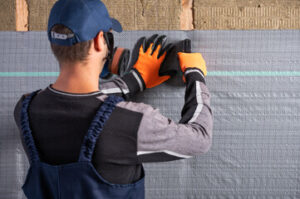A radiant barrier is a type of insulation that reflects radiant heat, helping to reduce energy bills. It can also be supplemented with thermal insulation that slows conduction and convection to provide additional savings.
A reflective material on the hot side of your roof prevents radiant heat from reaching cooling air ducts in the attic. That can help reduce your cooling costs during summer. Read https://www.ultimateradiantbarrier.com/ to learn more.

Reflective insulation is manufactured in very thin bubble or board forms that are easy to work with, making them popular in insulating walls and ceilings. These products help keep summer and winter heat out, particularly in warmer climates, or in non-living areas like garages. They can also be combined with other types of insulation to boost the R-value, add sound insulating value, and reduce condensation.
While installing reflective insulation in older homes is possible, a professional installer should always be used for new construction projects. These professionals can ensure the radiant barrier is properly installed to minimize dust accumulation and prevent electrical shock. They can also provide installation tips and help ensure the product meets local building and fire codes.
Radiant barriers include foil-faced kraft paper, plastic film, or polyethylene bubbles. They are typically bonded to a middle layer of air infiltration and insulating foam or cellulose, which increases their R-value. A reflective surface is applied to both sides of the material for enhanced thermal performance. A vapor retarder (dissipative membrane) is also often included in the manufacturing process.
The primary function of radiant barriers is to reduce heat flow through open spaces, such as attics, which are a significant source of energy loss in homes and buildings. Different types of insulation facilitate heat transfer by conduction, convection, and radiation to varying degrees and, therefore, have different R-values.
Because radiant barriers reduce the flow of heat through open spaces, they are primarily useful in hot regions. They can be combined with other types of insulation materials to improve their R-value, enhance their thermal performance, reduce condensation, and increase the efficiency of HVAC systems.
While it is possible to see energy savings with the use of radiant barriers in homes and businesses, exact results are still being determined. Manufacturers and retailers can make exaggerated claims about the energy savings that can be expected, but these claims are not based on scientific testing or verified data. The Trade Association is dedicated to distributing reliable radiant barrier and interior radiation control coating product technical information that helps consumers distinguish between real and fraudulent energy-saving claims.
Foil insulation is a popular and highly efficient option for both new build and refurbishment projects. It is also a cost-effective way to save on cooling costs during the summer and prevent heat loss in winter. Foil insulation has a reflective surface, which helps to reduce radiant heat gain. However, it does not reduce heat conduction like thermal insulation. Foil insulation is most effective in warm climates and will help to reduce your energy bills by reducing the load on your air conditioning system.
It also works in conjunction with other types of insulation and can be used as a vapor barrier to prevent moisture from entering a building. It also stops condensation and mold growth, which can be a significant health risk to the people living in the building.
Multifoil insulation consists of thin layers of foil alternating with sections of thermal foam or polypropylene wadding. This combination of materials gives it excellent insulating properties and a high R-value. Unlike more traditional types of insulation, it doesn’t require any additional batting or fabric to increase its R-value. Foil insulation is an affordable alternative to more costly options such as mineral wool or PIR board insulation.
Reflective insulation was re-popularised by the space industry as it was needed to protect astronauts from the radiation emitted from the sun while working in outer space. It is a simple but very effective material and has been around for thousands of years.
The foil reflects the radiant heat from the sun, which keeps the inside of your home cool during the summer. It can also reduce energy costs in winter by reflecting the heat into a room.
Foil insulation is an environmentally friendly product that is easy to install and does not need maintenance. It is also very light, making it easy to move around, handle, and store when not in use. It can be combined with other forms of insulation, such as fiberglass or cellulose, to improve its performance and R-value. It is durable and will not compress, disintegrate, or rot over time. It is a great choice for refurbishment projects as it can be installed easily into existing walls and ceilings.
Radiant barriers reflect radiant heat rather than absorbing it. Since heat can also be transferred by conduction and convection, a radiant barrier is often supplemented with thermal insulation that slows energy transfer. The result is a highly reflective building material that reduces the energy required to maintain a comfortable temperature in your home, office, warehouse, or pole barn.
The type of radiant barrier you choose depends on the climate in which your structure is located and how much additional cooling energy you need. A properly installed radiant barrier can reduce cooling costs by 5% to 10%.
Different manufacturers offer a wide range of radiant barrier products, from spray-on and breathable house wrap radiant barriers to sheathing radiant ones installed on the roof. Understanding the differences in strength, durability, water vapor permeability, and flammability between the various types is important.
You should always check the current ASTM C1313 testing results when shopping for a radiant barrier. It is important to avoid products that do not meet these requirements. A good radiant barrier should be at least rated to withstand a Class F flame spread and smoke development.
Several types of radiant barriers are available for new construction and retrofit applications. Most commonly, radiant barriers are installed in attics of residential structures to reflect radiant heat from the sun and reduce cooling costs. In warm climates, radiant barriers can lower cooling costs by 5% to 10%.
While radiant barriers can increase the efficiency of your air conditioning system, they do not stop heat transfer through ductwork. The best way to reduce cooling costs with a radiant barrier is by combining it with thermal insulation and using a programmable thermostat to ensure you are getting the most energy savings.
All materials give off thermal radiation at varying rates, referred to as the material’s emissivity. The lower the emissivity, the less radiant heat it gives off. The emissivity of a radiant barrier is usually measured on the surface that faces the heat source. The best radiant barriers have a high reflectivity rating and low emissivity. This combination provides maximum performance and is ideal for homes in warm climates.
Vacuum insulation panels are one of the newer types of thermal insulation that have come to market. They have a very low thermal conductivity and can reduce energy costs and carbon emissions in buildings. They are also much thinner than conventional insulations and can save space in building walls. These VIPs are made of an open-pore core of fumed silica or fibrous material enveloped in barrier materials consisting of multilayered metalized polymer laminate films. These layers create a vacuum inside the heart of the VIP, reducing convection, conductive, and radiation heat transfer. The VIPs can be combined with multilayer insulation (MLI) to improve the system’s performance at cryogenic temperatures and meet fire safety requirements.
Like reflective insulation, it works by reflecting radiant heat rather than absorbing it. It is often used in attics to limit summer heat gain and help lower cooling costs, although it can be installed throughout the house. It can be combined with conventional insulation, such as fiberglass or mineral wool, and can help reduce conductive and convective heat flow.
Conventional insulations, such as plastic foam or cellulose, contain trapped air bubbles that help to boost their effectiveness. Unlike these materials, vacuum insulation has no air. A vacuum is a space, meaning it can’t hold any molecules. Heat transfer through conduction requires the collision of molecules, so a vacuum cannot slow or stop conduction. Convection, on the other hand, needs a gas that can develop convection currents. Since no gas is in a vacuum, it can’t slow or stop convection either.
A vacuum insulation panel has an outer layer or ‘envelope’ made from a material impermeable to both water and gases. The outer envelope of the board must be strong enough to withstand the mechanical pressure applied by the forming process while also providing an airtight seal. The vacuum in a vacuum insulation panel will gradually degrade as air enters the insulation and normalizes its pressure with the environment. Still, the panel’s R-value quality can be maintained for an extended period through strict manufacturing and proper installation techniques.
